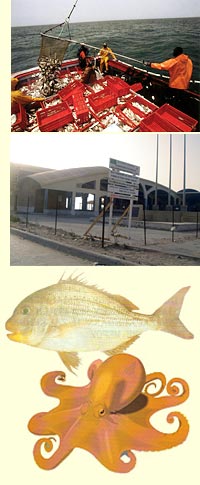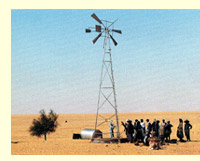 |
 |
|
 Cooperation with Japan Cooperation with Japan
 1- Marked by some specific assistance in mining and fisheries sectors at the end of the seventies ( export of Mauritanian iron ore to Japan with some Japanese loans to the SNIM <National Mining and Industrial Company>, fisheries production processing plant in Nouadhibou and some fishing vessels with permit), the Mauritano- Japanese cooperation became more and more efficient considering the important role of Japan in International stage as number one in term of ODA grant. 1- Marked by some specific assistance in mining and fisheries sectors at the end of the seventies ( export of Mauritanian iron ore to Japan with some Japanese loans to the SNIM <National Mining and Industrial Company>, fisheries production processing plant in Nouadhibou and some fishing vessels with permit), the Mauritano- Japanese cooperation became more and more efficient considering the important role of Japan in International stage as number one in term of ODA grant.
2- In Mauritania, this situation has led to financing several projects in different fields (hydraulic, health, education, fisheries, rural development and so on…).
3- On the other hand, our country
has benefited ,since 1981 , important Japanese
assistance as a non-project grant aid among
the 21 sub- saharian countries that have implemented
a structural adjustment program supported by World Bank
and International Monetary funds: debt alleviation measures,
subsides for the improvement of agricultural production and
aid in foreign currency to buy cereals.
4- In 1988,1990,1992,1994, 1996, 1998 and 2001 Japan granted to our country seven (7) non-project aids estimated to 6,300, 000,000 yen , most of it was used to finance the installation of equipments for the SNIM.
5- Japan accorded three loans
to Mauritania used respectively: in 1989, for the support
to SNIM activities (3,500,000,000 yen), in 1993, the Adjustment
Program of the Public Sector(APPES) ( 4,663,000,000 yen) and
in 1995, the development program of the private sector ( 2,
821,000,000 yen).
6- Japan has, since 1989, decided
nineteen (19) debt alleviations aids for Mauritania. These
subsides have been totally left to SNIM, in order to acquire
equipments for its financial restructure.
We remark that Japan has recently decided of the cancellation of our debt within the initiative of VIPC( Very Indebted Poor Countries).
7- The government of Japan grants annually two aids to our country since 1981. These aids are:
- Food aid (KRI) from 150,000,000 yen to 350,000,000
yen.
- Improvement of agricultural production (KRII) from 200,000,000
yen to 400,000,000 yen the latter helps the rural development
department to acquire equipments and agricultural input
(supplements).
 8- Trainees from our country have profited several training sessions in Japan, these last couple of years, in different fields such as tropical medicine, naval construction and reparation, computing, mechanic auto and so on… Japanese technical assistance is a good preliminary for a more substantial financial cooperation thanks to the promotion by experts of the procedures and characteristics of the Japanese cooperation system. 8- Trainees from our country have profited several training sessions in Japan, these last couple of years, in different fields such as tropical medicine, naval construction and reparation, computing, mechanic auto and so on… Japanese technical assistance is a good preliminary for a more substantial financial cooperation thanks to the promotion by experts of the procedures and characteristics of the Japanese cooperation system.
Adding to its volume and fields of action diversity, Japanese cooperation has contributed a lot to the necessities of our national development strategy.
 Chart showing japanese assistance to IRM for the last 3 years Chart showing japanese assistance to IRM for the last 3 years
(¥thousand)
| PROJECT |
2002 |
2003 |
2004 |
2005 |
2006 |
| Project for Water Supply in KIFFA |
¥1,288,000 |
|
¥290,000 |
|
|
| Debt Relief |
¥340,965 |
¥198,310 |
¥7,956,273 |
|
|
| Food Aid |
¥250,000 |
¥300,000 |
¥300,000 |
¥300,000 |
¥300,000 |
| Grant Aid for Increase of Food Production |
¥400,000 |
|
¥174,000 |
|
|
| Supply of equipment for exhibition to the National Museum of Nouakchott |
¥25,400 |
|
|
|
|
| Project for improving Maternal and Child Healthe Care in Mauritania (through UNICEF) |
|
¥290,000 |
|
|
|
| Grant Aid for security improvement of processed marine products |
|
|
¥1,018,000 |
|
|
| Assistance to FAO's Desert Locust Control Project in Chad, Mali and Mauritania |
|
|
¥330,273 |
|
|
| Project for Water Supply in the Southern Region |
|
|
|
¥327,000 |
|
| Project for the Construction of Classrooms for Basic Primary and Secondary Education in the Cities of Nouakchott and Nouadhibou |
|
|
|
¥950,000 |
¥1,073,000 |
| Emergency Grant Aid for the Electoral Process in the Islamic Republic of Mauritania |
|
|
|
|
¥130,000 |
 Page Top Page Top |